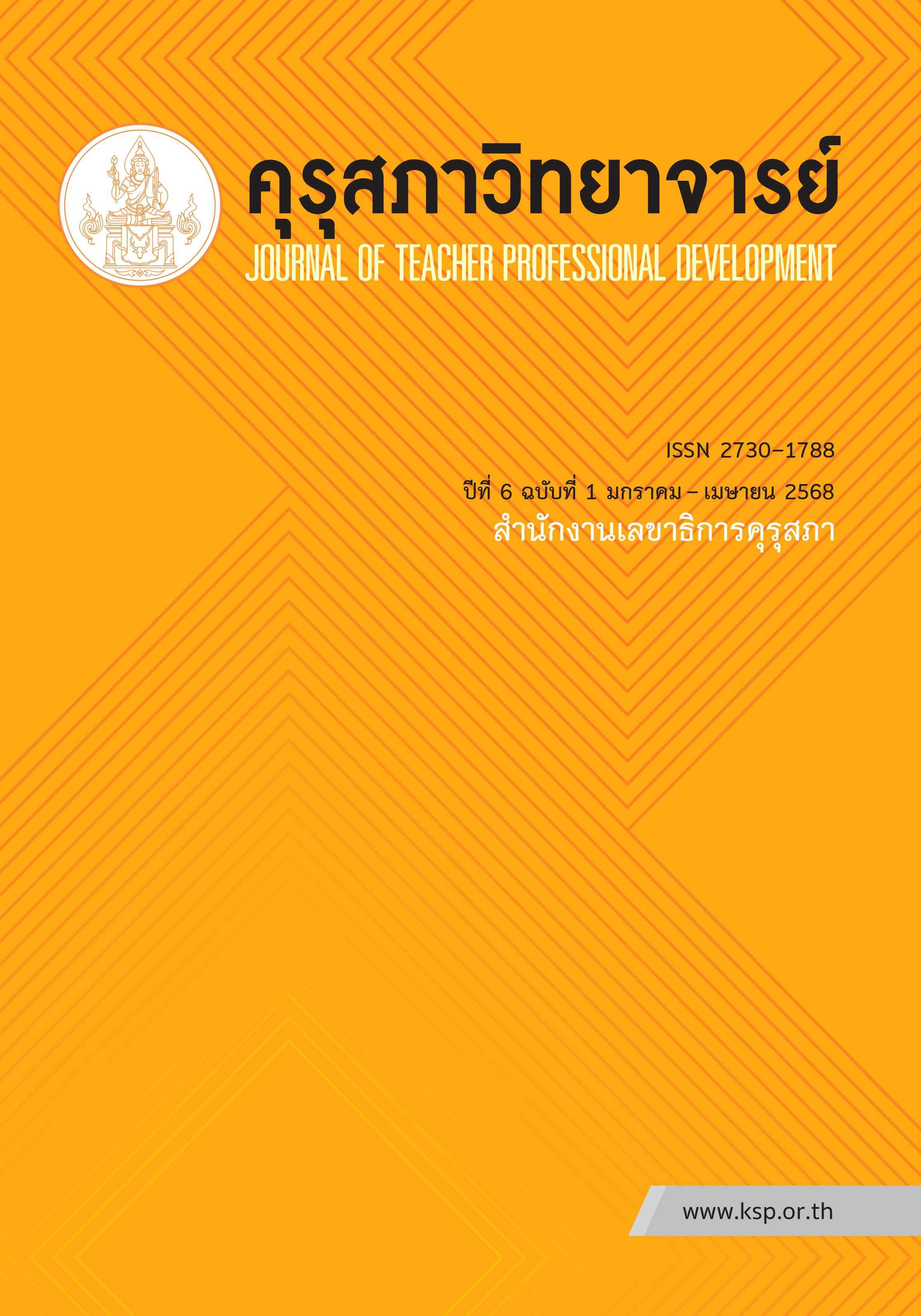ปัญญาประดิษฐ์ (AI) : การประยุกต์ใช้ทางการศึกษา
Main Article Content
บทคัดย่อ
ปัญญาประดิษฐ์ (Artificial Intelligence) หรือ AI เป็นเทคโนโลยี ที่กำลังมีการพัฒนาอย่างต่อเนื่องและมากขึ้นเพื่อมาช่วยมนุษย์ในการดำเนินชีวิตและการทำงาน โดยมีแนวโน้มในการนำปัญญาประดิษฐ์มาทำงานแทนมนุษย์ในหลายภาคส่วน ปัจจุบันได้ก้าวข้ามการทดลองใช้สู่การประยุกต์ใช้อย่างจริงจัง และได้มีการพัฒนาปัญญาประดิษฐ์ในวงการศึกษาโดยมีการศึกษาและวิจัยในหลายๆประเทศ และได้มีการถ่ายทอดองค์ความรู้เกี่ยวกับปัญญาประดิษฐ์ด้านการศึกษา ด้วยความสามารถในการปรับปรุงการสอนและสร้างประสบการณ์การเรียนรู้ที่ดีขึ้น การจัดการเรียนรู้บนฐาน AI เป็นที่นิยมในการพัฒนาการศึกษาในปัจจุบัน การใช้ AI ในการจัดการเรียนรู้ช่วยให้สามารถปรับปรุงการสอนให้เหมาะสมและมีประสิทธิภาพมากขึ้น โดยสามารถปรับปรุงเนื้อหาการเรียนรู้ให้เหมาะสมกับระดับความเข้าใจของนักเรียนแต่ละคน บทความนี้กล่าวถึงเนื้อหาสำคัญของปัญญาประดิษฐ์ ได้แก่ นัยของปัญญาประดิษฐ์ ขอบเขตของปัญญาประดิษฐ์ การก่อกำเนิดปัญญาประดิษฐ์ มิติการนำปัญญาประดิษฐ์มาใช้เพื่อการศึกษา และบทสรุป
Article Details
เนื้อหาและข้อมูลในบทความที่ลงตีพิมพ์ในวารสารคุรุสภาวิทยาจารย์ ถือเป็นข้อคิดเห็นและความรับผิดชอบของผู้เขียนบทความโดยตรง ซึ่งกองบรรณาธิการคุรุสภาวารสารไม่จาเป็นต้องเห็นด้วย หรือร่วมรับผิดชอบใด ๆ บทความ ข้อมูล เนื้อหา รูปภาพ ฯลฯ ที่ได้รับการตีพิมพ์ในวารสารคุรุสภาวิทยาจารย์ ถือเป็นลิขสิทธิ์ของวารสารคุรุสภาวิทยาจารย์ หากบุคคลหรือหน่วยงานใดต้องการนาทั้งหมดหรือส่วนหนึ่งส่วนใดไปเผยแพร่ต่อหรือเพื่อกระทาการใด ๆ จะต้องได้รับอนุญาตเป็นลายลักอักษรณ์จากวารสารคุรุสภาวิทยาจารย์ก่อนเท่านั้น
เอกสารอ้างอิง
ฉัตรพงศ์ ชูแสงนิล. (2562). ปัญญาประดิษฐ์เพื่อการเรียนรู้. สืบค้นจาก https://www.scimath.org/article-technology/item/10110-ai-10110
วรลักษณ์ หิมะกลัส. (2566). การทบทวนวรรณกรรมว่าด้วยการใช้ AI ในการศึกษา. สืบค้นhttps://www.khonthai4-0.net/system/resource/file/kpfgo_content_attach_file_522_1.pdf?date=2023-12-28+15%3A24%3A10.1
วิชัย วงษ์ใหญ่ และ มารุต พัฒผล. (2562). การจัดการเรียนรู้ยุค AI.บัณฑิตวิทยาลัย มหาวิทยาลัย
ศรีนครินทรวิโรฒ.
ศุภณัฐ-เติมชัยอนันต์. (2566). AI กับอนาคตการศึกษา: ตัวช่วยที่ทำให้เด็กเก่งขึ้น หรือตัวการขัดขวางการเรียนรู้ ทำลายอาชีพครู. สืบค้นจาก https://thepotential.org/knowledge/ai-future-education/
สำนักงานราชบัณฑิตยสภา. (2562). ศัพท์คอมพิวเตอร์และเทคโนโลยีสาร สนเทศ. สืบค้นจาก www.royin.go.th
สำนักงานเลขาธิการสภาการศึกษา กระทรวงศึกษาธิการ. (2563) AI เพื่อพัฒนาการเรียนรู้
Copeland, B. J. (2020). Artificial Intelligence. Retrieved from www.britannica.com
Copeland, B. J. (2023). Artificial Intelligence. Retrieved from https://www.britannica.com/technology/artificial-intelligence
CYBERNETYX Group. (2019). How AI Assistants Are Helping Teachers in the Classroom? Retrieved September, 4, 2019 from https://www.eins.ai/how-ai-teachingassistants-help-teachers-to-teach-effectively/
European Commission. (2018). The Impact of Artificial Intelligence on Learning,Teaching, and Education. Retrieved from http://ec.europa.eu/jrc
Lewis, T. (2014). A Brief History of Artificial Intelligence. Retrieved from www.livescience.com.
Miao, F., Holmes, W., Huang, R., & Zhang, H. (2021). AI and education: A guidance for policymakers. UNESCO Publishing
Microsoft Australia Education. (2019). Artificial Intelligence in the Classroom. Retrieved September, 4, 2019 from https://educationblog.microsoft.com/en- au/2019/01 /artificial-intelligence-in-the-classroom/
Parinya Mingsakul. (28 กันยายน 2566). Generative AI เทคโนโลยีพลิกโฉมโลก. วิจัยกรุงศรี. https://www.krungsri.com/th/research/research-intelligence/generative-ai-2023.
Poth, R. D. (2019). Artificial Intelligence: Implications for the Future of Education. Retrieved September, 4, 2019 from https://www.gettingsmart.com/2018/01/artificialintelligence-implications-for-the-future-of-education/
Segal, T. (2019). Decision Tree. Retrieved from https:// investopedia.com
TeachThought Staff. (2019). 10 Roles for Artificial Intelligence In Education. Retrieved September, 4, 2019 from https://www.teachthought.com/the-future-of-learning /10-roles-for-artificial-intelligence-in-education/
UNESCO. (2019). Artificial Intelligence in Education: Challenges and Opportunities for Sustainable Development. Retrieved from http://en.unesco.org/themes/education policy-planning/
Zhai, X., Chu, X., Chai, C. S., Jong, M. S. Y., Istenic, A., Spector, M., ... & Li, Y. (2021). A Review of Artificial Intelligence (AI) in Education from 2010 to 2020. Complexity, 2021, 1-18.


